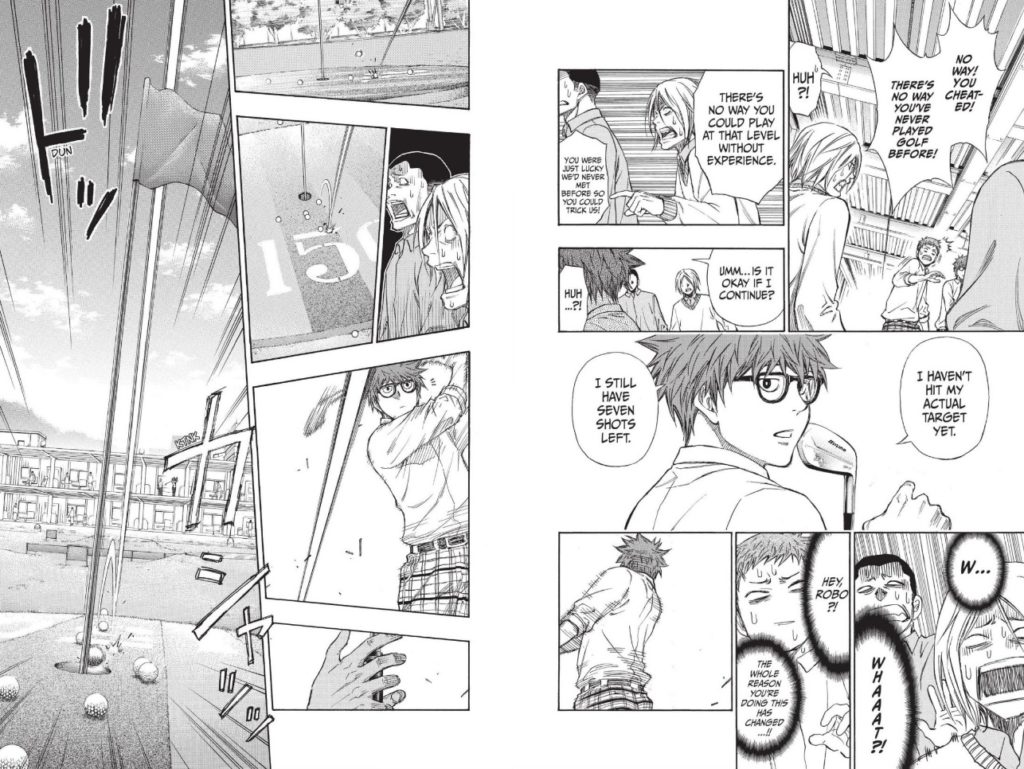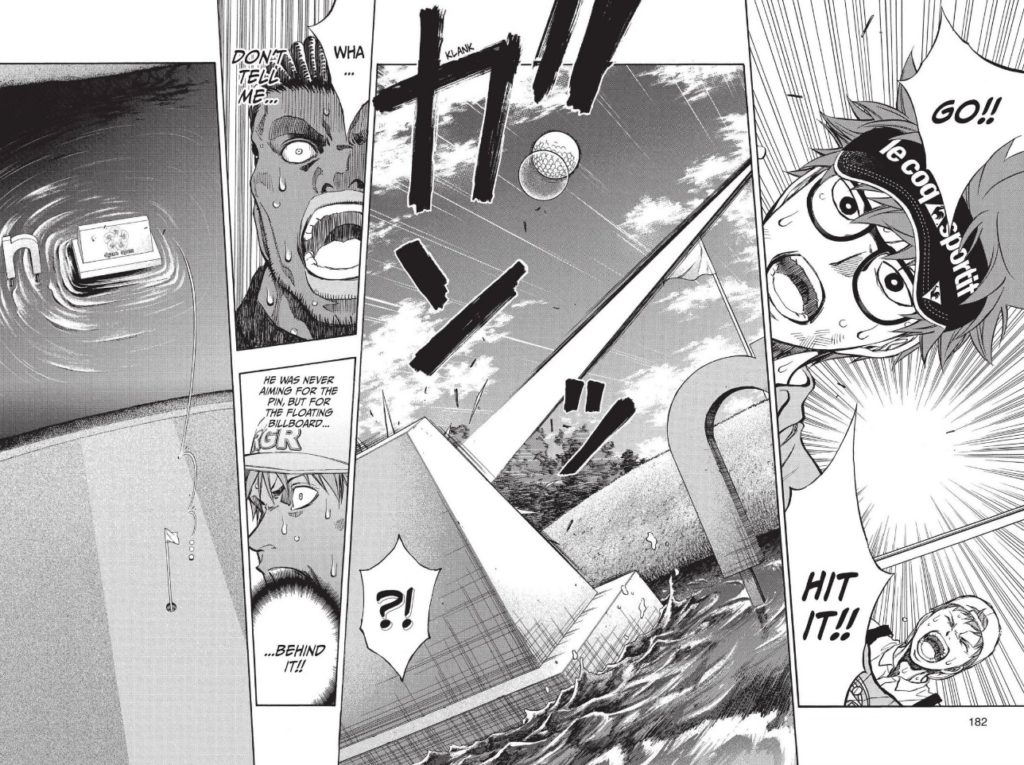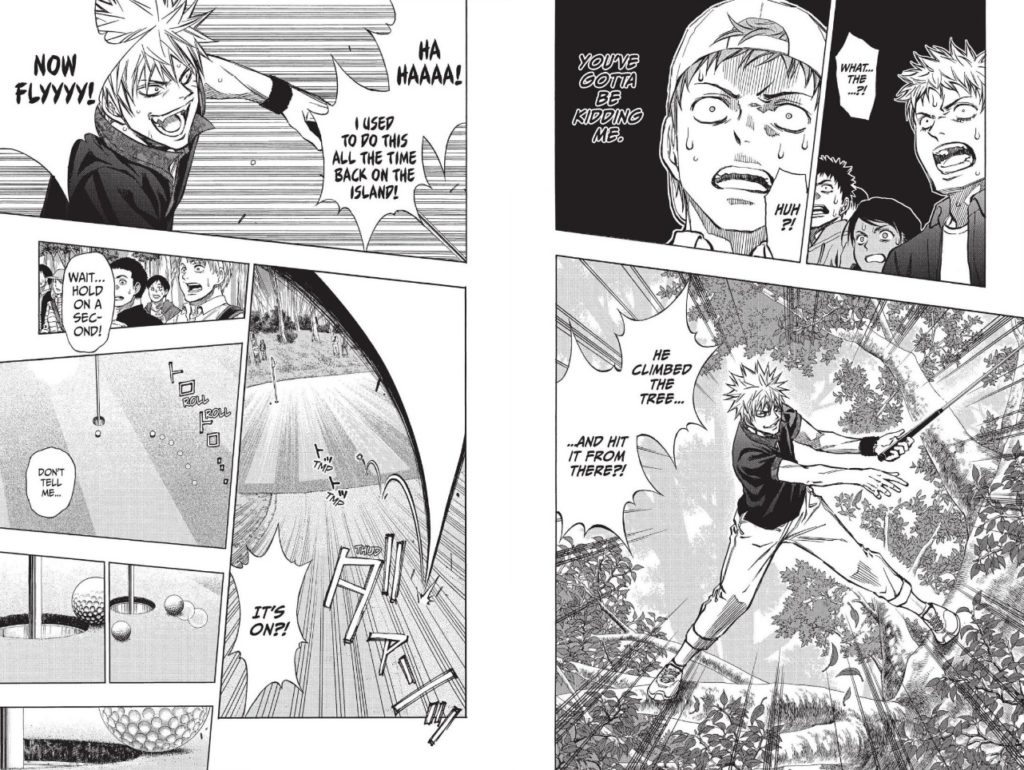Lockdown Reads: Robot x Laserbeam
WARNING: Contains spoilers.
Golf manga Robot x Laserbeam (RxL) is probably mostly noted for its author, Tadatoshi Fujimaki, who made a name for himself with another sports manga, Kuroko’s Basketball.
However, while Kuroko is fondly remembered, running for 30 volumes and having three anime TV series, RxL ended up being Fujimaki’s “difficult second album” and never achieved the same level of success, running for just over one year while Kuroko ran for over five years.. Only seven volumes were released before Weekly Shonen Jump gave up on it, with Fujimaki making clear that he had more to tell. While Kuroko was released by VIZ Media in a series of 2-in-1 print volumes, VIZ gave RxL a digital-only release back in September 2020, although the release itself appears to have no issues regarding Christine Dashiell’s translation or the lettering by Vanessa Satone and Annaliese Christman.
Why did RxL fail to gain the same popularity as its predecessor? In terms of the sport, golf is certainly more popular than many other sports that have been the subject of more popular manga – volleyball-based Haikyu!! for example. Is it a lack of the Odagiri effect, that peculiar phenomenon where works of fiction get a larger than expected female following because of the attractive male characters? It’s true that none of the main characters are outright stunning in attractiveness, although there are moments of fan service, thanks to Japan being probably the only country in the world where they put bathhouses in the clubs (that’s “clubs” as in the place where you play golf, rather than the club you hit the ball with). Also, you can imagine several British readers going: “Not sexy. Ginger.”
However, having read the entire series, it seems it has more to do with trying to make golf exciting to a Shonen Jump audience. Some of the things that appear in RxL are so ludicrous that any casual golf fan, let alone hardcore followers, would read them and go: “Like that would ever f***ing happen!” In fact, there are so many cases of this, that for the rest of this article I will be using initialism LTWEFH to save time.
RxL follows Robota Hatohara, more commonly known as Robo because he is so expressionless and blunt. His face seems to show no emotion at all, much like Kuroko in Fujimaki’s previous work. His father is a chef, while his mother is a kimono instructor from Scotland, from whom Robo gets his distinctive ginger hair. Robo’s best friend is Tomoya Nakata, a member of their school’s golf club who is constantly trying to get Robo to join, but Robo has no interest in anything competitive.
Tomoya manages however to persuade Robo to visit a driving range. Tomoya’s lack of skill is mocked by some onlookers, so Robo puts them in their place by executing some brilliant drives, learning incredibly quickly from his mistakes, and in just eight shots this seemingly total beginner is able to get a 150 yard hole-in-one with laser-beam-like accuracy. While this might seem like a LTWEFH moment, we later learn that Robo has in fact been practicing golf using his father’s old club and a basket for years, so he actually has some properly legitimate skill.

Robo’s shots are overheard by Yozan Miura, currently the big name in the amateur golf scene. After a mix-up where Yozan thinks it is Tomoya who has this amazing accuracy, Yozan discovers that it is Robo who has this ability to get accurate drives. However, when they all go to an actual golf course, it becomes clear that, apart from the drives, Robo has no other skill except his ability to learn and adapt quickly. When he makes a mistake, Robo is able to learn from Yozan as to how to get back into the game. Yozan tells Robo to get up to his level and for them to have a rematch when Robo has more skill, with Yozan later declaring Robo his rival in an interview. Robo thus ends up joining the school golf club.
The first half (or rather what ended up being the first half) of the series follows the typical schoolboy sports manga tropes: Robo has to take part in all sorts of physical tests, which for those who don’t know golf might come as a surprise. When you are watching it on the telly, golf doesn’t look physically demanding, but when you are playing on your own, having to carry a considerable weight of golf clubs on your back across 18 holes, there is more physical labour than you might be expecting. One of things that constantly crops up across the series is the need for stamina to play all of these holes. There is also the training from upperclassmen in the club, and the typical female coach that serves as the lone regular female character in Robo’s age group throughout the entire story.
However, unlike most sport series of this type, we don’t see much in the way of training, or at least that was Fujimaki’s intention before the series got axed. Partway through Volume 4, almost exactly halfway through the entire series as it would turn out, RxL skips forward three years. The rest of the series takes place after the characters have left school, with Robo now taking part in open competitions as an amateur, with Tomoya working as Robo’s caddie, and Yozan now in the US playing as a professional.

After completing one competition, Robo enters another prestigious contest, but when he insults the mobster-like organiser named Don Ohkuma during a live TV interview because he rudely bumped into Tomoya, the organiser tries his best to rig the contest. It was obviously Fujimaki’s intention to show Robo make his way through at least several rounds of the contest, but Robo is only shown winning the opening round in the final chapter. The series ends by skipping forward in time to show Robo, now professional, in the same competition as Yozan, with Robo’s last ever shot in the manga being to tee off from the first in the US Open.
RxL is a manga that is not without merit. Robo is certainly an entertaining and often comedic character with Tomoya acting as his straight man, which itself is amusing given that Robo is the one with the straight face all the time. His background, with his Scottish mother, may also interest some UK readers. However, Robo does feel rather too similar to Kuroko from Kuroko’s Basketball, whose expressionless nature was also one of the main things behind his character.
The manga also does have some diversity. Robo is obviously mixed race due to him having a Japanese father and Scottish mother. There also people of colour in RxL too, with Robo playing and becoming friends with a black South African golfer in the second half of the series called Dorian Green. Whether he has a Dorian Gray-like portrait or personality is never explained, but given that we know he comes from a poor background and he is hoping to win so he can send the prize money back to his impoverished family, it is unlikely.
There are other moments in the manga where certain attitudes might be more questionable. In the sixth volume, Robo and his friends are relaxing at a golf club, complete with bath, following a tournament. Then suddenly a peeping tom runs out of the lady’s bath having disguised himself as woman, despite clearly looking like a man, even having stubble on his face. He tries to run away, but another golfer who Robo is in conversation with, the unconventional Ginro Kuze, stops the peeping tom by performing a trick shot where he hits the ball with a broom handle to knock over a suit of armour that collapses on him. While the payoff is somewhat amusing, the whole scene does feel rather Linehan. You look at the entire situation, where you learn about a man dressing as a woman doing something perverted in a ‘ladies only’ area, and while of course there are legitimate concerns about this kind of unwanted behaviour, there is that tiny part of me that thinks: “Did J. K. Rowling write this?”
However, to me, the greatest flaw in RxL is the fact that so many of the things depicted are so implausible that if they ever happened actually on a golf course right in front of you, you would not believe it. The first of these is in Volume 3, where Robo is playing against an elite player from another school, Kyosuke “Emperor” Suzaku, your typical privileged, wealthy character who is there to be hated. Both sides are level as Robo and Kyosuke, the final pair, go into the Par 4 18th hole. Kyosuke lands on the green in two strokes, meaning he should easily get a birdie. In response, an exhausted Robo uses his laser beam skills to amazingly score an eagle and win the match… but not just any eagle. Not only does he manage to get his ball in the hole, but Robo does it by getting his ball to strike Kyosuke’s ball, and then Robo’s ball rolls in. LTWEFH!

I’m no golfing expert, but my guess that there has never been in the history of the professional game a case where anyone has won a game of golf on the 18th hole by scoring an eagle in which they strike their opponent’s ball and roll into the hole. Show me film footage of such a thing happening, and I still won’t believe you.
Then there is the incident in Robo’s game with Dorian in Volume 5, on the 1 handicap hole (the hardest on the course). The green is almost entirely surrounded by a water hazard. Dorian lands in the water, but rather than play conservatively Robo decides to land right next to the pin. Robo unlocks his “special ability” for want of a better term, a massive amount of precise concentration which he dubs the “Ex Laser”, at a level of 120%. Robo strikes, but overshoots past the green – a deliberate move, because Robo is not actually aiming for the pin, but at a floating billboard behind the pin, which the ball bounces off, lands on the green and rolls to within 20cm (8 inches) of the pin. LTWEFH! No-one in a proper tournament would play a shot like that in a million years.

Mind you, even the way Robo and Tomoya arrive for that competition is daft, as shown in Volume 4. Having made a diversion to take a woman to hospital, they know they won’t arrive at the course by car in time. This is where wealthy Kyosuke comes in handy, as he takes them to the course via his own helicopter. However, as there is no time to get to a heliport, the only way Robo and Tomoya are able to reach the course in time is to parachute out of it, with the golf clubs coming in a third parachute. LTWEFH! What sort of pro golfer parachutes onto the course at the very last moment, especially given the etiquette of golf courses? No golf course would allow people to parachute in. Damn it, some of the courses still refuse to let women on them.
It’s not just Robo who does these ludicrous things. Ginro also does something equally odd in Volume 7. Ginro lands his ball in a high tree branch. Normally, the ball is declared out-of-bounds and the player takes a penalty stroke. Instead, Ginro decides to climb the tree and play the ball where it is. While it is not uncommon for golfers to play the ball where it lies if it is in the water, it is still rare. It’s even rarer to climb a bloody tree, whack the ball out of it and onto the main course. Ginro doesn’t do that however. Not only does Ginro get the ball out of the branch, he manages to land it in the hole for a birdie, stealing the hole from Robo. LTWEFH! Who has ever scored a birdie from hitting a ball from a high tree branch?

Perhaps the most infuriating part of all this however is a comment that Fujimaki makes himself. Between each chapter is a short “Golf Lesson Trivia” section explaining certain aspects of the game. After one chapter in Volume 5 ends with Robo using his Ex Laser to get a hole-in-one, Fujimaki goes on to explain the curious custom that you may know about Japanese golf: that if you get a hole-in-one, the person who achieves it has to spend money on parties and gifts to celebrate it. As a result, in Japan there is “hole-in-one insurance” to cover the cost of these expenses. Fujimaki comments on the practice, saying, “Personally, I think it’s ridiculous.” THIS is ridiculous? You’ve written and drawn your characters getting eagles by hitting other people’s balls, landing on the green by bounding off billboards, arriving on the course via parachute and scoring birdies from tree branches, and THAT’S the ridiculous bit?
RxL is a series with its ups and downs. Part of me wished that there was more of it, although that is partly because I want to see what bizarre shots Robo would have to pull in order to finally reach the US Open. The problem with it is that golf doesn’t feel like the kind of sport that you can write about in your typical Shonen Jump way.
Golf has been the subject of successful manga. Probably the most famous is Kaze no Daichi (Windy Plains) by Nobuhiro Sakata and Eiji Kazama. The series, which is aimed at the older seinen age group, began in 1990, won the “General Manga” prize at the Shogakukan Manga Awards in 1993, and is still going to this very day. Sadly this series is not available in English, which is a great shame because I really want to read it now to see how the two compare.
It’s not just this title, there are many other classic sports manga that have not been released in English. Perhaps the greatest is Yoichi Takahashi’s football manga Captain Tsubasa, a series that inspire world-famous footballers to take up the sport, and I mean names you will have heard of: Fernando Torres, Zinedine Zidane, Lionel Messi and Alexis Sanchez to name just some of them. The original series and its spin-offs have been going since 1981, and it has still never been released in English.
As for RxL, feel free to give it a go. If you are willing to let the more bizarre things wash over you, the series is still entertaining and comedic enough to please the average reader. Alternatively, you can also re-read or re-watch Kuroko’s Basketball.
All seven volumes of Robot x Laserbeam are available to download as e-books by VIZ Media. Kuroko’s Basketball is available in both print and e-book format by VIZ Media, with the anime available on both Crunchyroll and Netflix.


